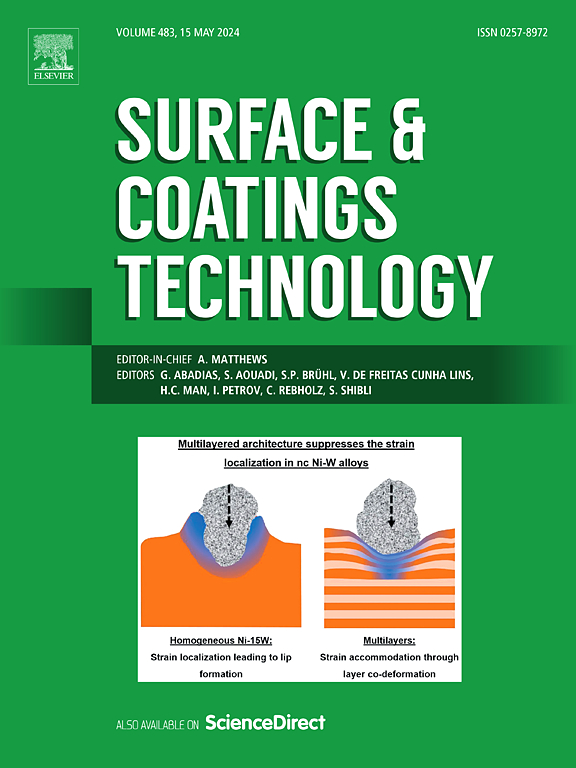alf3活化包埋法制备K447A镍基高温合金渗铝涂层的组织与氧化行为
IF 5.3
2区 材料科学
Q1 MATERIALS SCIENCE, COATINGS & FILMS
引用次数: 0
摘要
系统地研究了AlF3活化剂的作用、K447A镍基高温合金包埋过程中镀铝层的形成机理及其氧化行为。通过XRD、SEM、TEM、EDS等综合表征及HSC热化学计算,得出了四个主要发现:AlF3表现出最佳的渗铝能力,并通过Al气体的歧化反应生成活性Al原子;渗铝涂层呈多层结构,外层由高铝含量的Ni2Al3或NiAl3组成,内层由NiAl组成。析出相如α-(Cr, W)、σ相和碳化物分布在铝化物中,证实了al主导的“高活性”向内扩散机制。涂层厚度与温度和保温时间呈线性关系。Ni₂Al₃在NiAl之前形成,转化为NiAl,然后再生。在1150℃氧化100 h后,氧化铝涂层上形成一层脊状α-Al2O3保护膜,有效地屏蔽了基体。本文章由计算机程序翻译,如有差异,请以英文原文为准。
Microstructure and oxidation behavior of the aluminized coating on K447A nickel-based superalloy prepared by AlF3-activated pack cementation
The function of AlF3 activator, the aluminized coating formation mechanism on K447A nickel-based superalloy during the pack cementation process, and their oxidation behaviors have been systematically investigated. Comprehensive characterization by XRD, SEM, TEM and EDS analyses with HSC thermochemical calculation reveals four key findings: AlF3 demonstrates the optimal aluminizing capability and generates active Al atoms via the disproportionation reaction of AlF gas. The aluminized coating exhibits a multilayer structure, with the outer layer composed of high Al content Ni2Al3 or NiAl3 and the inner layer consisting of NiAl. Precipitated phases such as α-(Cr, W), σ phase, and carbides are distributed in the aluminides, confirming an Al-dominated inward diffusion mechanism characteristic of a “high-activity” process. The coating thickness exhibits linear relationships to the reciprocal of temperature and holding time. Ni₂Al₃ is formed before NiAl, transforms into NiAl, and then is regenerated. After oxidizing at 1150 °C for 100 h, a protective ridged α-Al2O3 scale forms on the aluminide coating, effectively shielding the substrate.
求助全文
通过发布文献求助,成功后即可免费获取论文全文。
去求助
来源期刊

Surface & Coatings Technology
工程技术-材料科学:膜
CiteScore
10.00
自引率
11.10%
发文量
921
审稿时长
19 days
期刊介绍:
Surface and Coatings Technology is an international archival journal publishing scientific papers on significant developments in surface and interface engineering to modify and improve the surface properties of materials for protection in demanding contact conditions or aggressive environments, or for enhanced functional performance. Contributions range from original scientific articles concerned with fundamental and applied aspects of research or direct applications of metallic, inorganic, organic and composite coatings, to invited reviews of current technology in specific areas. Papers submitted to this journal are expected to be in line with the following aspects in processes, and properties/performance:
A. Processes: Physical and chemical vapour deposition techniques, thermal and plasma spraying, surface modification by directed energy techniques such as ion, electron and laser beams, thermo-chemical treatment, wet chemical and electrochemical processes such as plating, sol-gel coating, anodization, plasma electrolytic oxidation, etc., but excluding painting.
B. Properties/performance: friction performance, wear resistance (e.g., abrasion, erosion, fretting, etc), corrosion and oxidation resistance, thermal protection, diffusion resistance, hydrophilicity/hydrophobicity, and properties relevant to smart materials behaviour and enhanced multifunctional performance for environmental, energy and medical applications, but excluding device aspects.
 求助内容:
求助内容: 应助结果提醒方式:
应助结果提醒方式:


